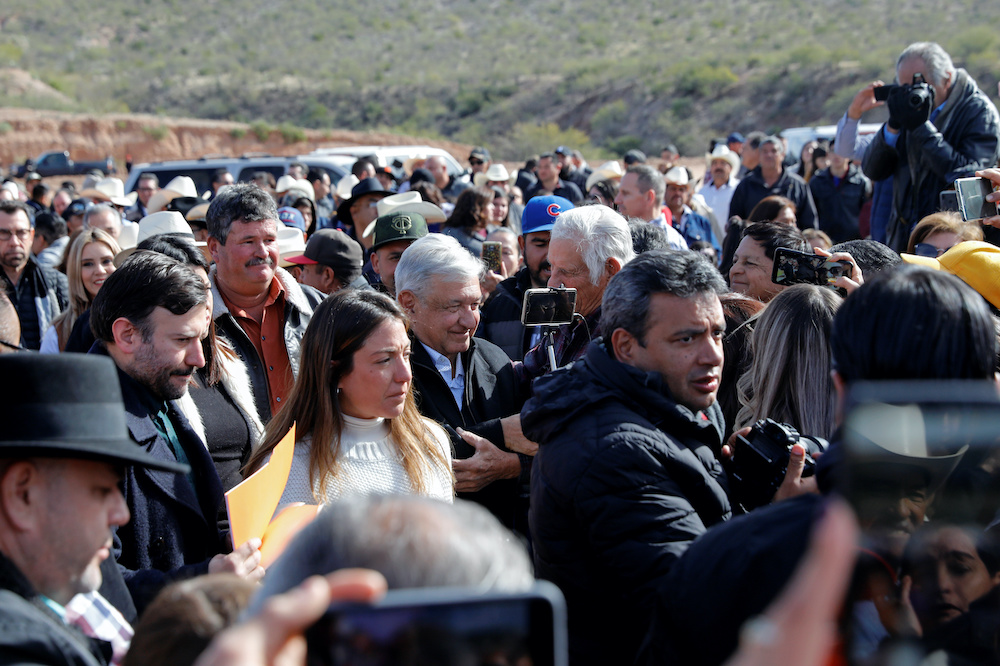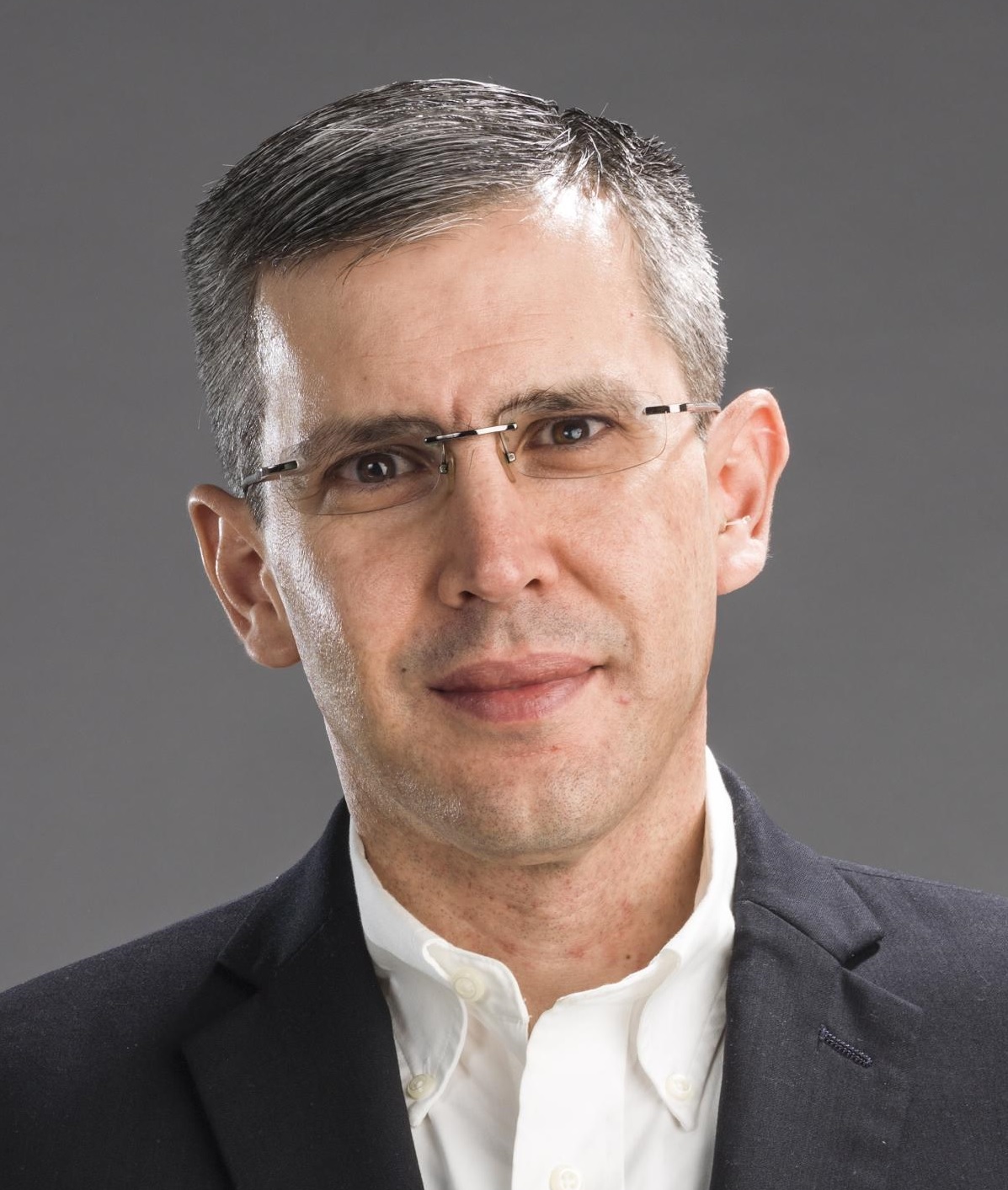
Mexico’s President Andrés Manuel López Obrador (center) is surrounded by members of the Mexican-American Mormon community during a visit to La Mora, Sonora, Mexico in January 2020
Translated by John Gibler. Leer en español.
More than one Mexican journalist found themselves perplexed. After federal authorities laid out the measures to avoid Covid-19 transmissions, such as keeping physical distance between people, President Andrés Manuel López Obrador has led massive rallies, eschewing those basic guidelines.
One journalist, squeezed in amongst the multitude, tweeted the following: “WE ARE 5 THOUSAND OR MORE WAITING FOR #president @lopezobrador THIS GOES AGAINST ALL THE CONTINGENCY RULES FOR #coronavirus (…) AND AGAINST HEALTH RECOMMENDATIONS.”
The president spent two weeks headlining mass events that journalists had to cover. At the same time those very journalists had to report on the sanitary measures contrary to the president’s agenda. All this took place in a politically and socially polarized climate that preceded the pandemic. With Covid-19, however, the polarization found fertile soil in the contradictory messages coming from within the government itself.
While the federal health ministry holds daily press conferences to update information about confirmed cases and to explain measures to fight the pandemic, López Obrador contradicts his own specialists. While federal health officials urged isolation, López Obrador put out a message calling on people to head out into the streets and help keep the economy alive. While the same health officials called on people to keep “social distance,” the president held huge rallies where he let himself be hugged and kissed babies. When asked about what measures he was taking to keep himself safe from the virus, he held up religious prints and amulets that would protect Mexicans from getting sick.
López Obrador’s administration, in contrast to other countries, has followed a strategy of protecting the economies of the poor and those who work in the informal sector, avoiding early and authoritarian lockdown measures. These decisions compete with the information circulating on social media that shows a consensus among Western countries on ordering citizens to stay at home — in many cases deploying security forces — and closing borders to avoid spreading contagion.
Upon being questioned about this strategy, the president has employed the formula he has used throughout his administration: accusing the political opposition and the press of being against him.
The reporter’s job of informing the public is hindered in this climate of contradictory official pronouncements coming from diverse chains of command, where questioning certain information is taken as journalistic bias.
Federal governmental offices closed on Friday, March 27. Federal freedom of information offices had closed five days before that. That closure froze a good deal of journalism. Concerns about the pandemic must be asked during the daily health ministry press conferences or the president’s daily conferences held on various issues.
The dangers of confusion, lack of information, and the spreading of false news during a health emergency taught Mexican journalists several lessons as we reported from the frontlines during the 2009 H1N1 epidemic that paralyzed the economy for several weeks.
That year we charged into the work without any kind of protection. We carried out interviews in hospital waiting rooms filled with patients with the most serious respiratory problems. We went to funerals. We interviewed family members of people who had died and of others who were sick. We went out into the streets when the country was under quarantine. Our only protection then was to wear surgical masks and avoid physical contact. More than a few of us came to feel symptoms that left us in bed thinking we were going to die.
That year we also doubted the official statistics. Then the government’s counting of H1N1 cases was lower than other counts. Even today, many Mexicans are left with the feeling that the government withheld information from us.
Eleven years later, the situation is not that different. A part of the population trusts the government to do things well, and another part thinks that the officials are lying. And again, journalists have the job of trying to verify the government’s discourse by heading out into the street to investigate. Journalists have to thus face the risks of trying to learn empirically and the risks of making mistakes.
On March 18, a woman stood outside a hospital to say that her husband had just died of the coronavirus even though he had not been tested. Journalists surrounded her. A short time later, the government confirmed her story and this was the first reported death from the contagion. The government also confirmed that the woman had the virus even though she was asymptomatic. Fear rose among the journalists who had first reported the news there.
The official information claiming to have faced this crisis correctly does not convince everyone. Reporters are investigating whether the government hid or reduced the use of tests, if they established filters in airports, if medical workers have the necessary equipment, if the hospitals have the capacity to face the pandemic, if coronavirus deaths have been camouflaged as pneumonia, if some coronavirus deaths were not reviewed by heath officials, if it is true or not that contagion from U.S. border cities couldn’t make it over the wall.
Such are the parallel realities where we receive news from crowded morgues and of horrible, solitary deaths in other countries, where the contagion increases every day in Mexico and where only 30 percent of Mexico City residents heeded the call to stay at home.
In journalist chat groups we started to ask hard questions, trying to foresee future scenarios. What will we do when newsrooms go into quarantine? Two employees of the nation’s largest television station have already tested positive for the virus. What will happen if a journalist is infected at an event they have been sent to cover? How to verify information when the call is to restrict contact and movement?
People have complained on social networks about media companies that have not allowed their employees to isolate themselves (“contradicting the measures recommended by authorities”). There have been layoffs and salary reductions. Journalists attempting to interview health workers have been attacked. There are continuing social media campaigns of dismissing journalists who question the government’s health policies. Group chats are filled with worried messages like these: “they called us to a press conference where we could not maintain physical distance,” “we had to follow the President’s schedule of events with all the journalists packed into a single SUV,” “how are people reporting in hospitals, because we can’t find any surgical masks.”
In newsrooms unfamiliar with the work-from-home culture it has been a challenge to fit the necessary changes into the dynamics of news production. There is also a marked digital divide between journalists not accustomed to technological advances.
Add to these logistical challenges the psychological ones. How to deal with the emotional impacts of covering a pandemic? In addition to the pressure of having to be constantly following the news and carrying out coverage, there is the accumulated stress of reporting on extreme violence in some areas, of job insecurities, and now of isolation.
A number of local journalist networks have established protocols for self-care while reporting, for requesting sanitary conditions in press conferences, safe working conditions from the owners of the media companies.
Groups of colleagues have begun to discuss this anxiety, or newsrooms where the entire staff needs virtual psychological support.
In this new reality of virtual communities of journalists, we are also beginning to design initiatives for organizing collaborative coverage of the pandemic, exchanging information among colleagues, and supporting the care measures proposed by the government. We are beginning to carry out workshops on social networks or other communication platforms to share safety tools, responsible reporting practices, and psychological support groups so that we can, as colleagues, all together, face the challenges this pandemic presents.



